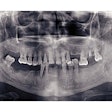
The percentage of body fat and adiposity may not be associated with caries in the permanent teeth of U.S. children and adolescents, according to a large study published recently in the Journal of the American Dental Association.
Although the fat mass index (FMI) score was linked with decayed, missing, and filled teeth and the lifetime caries prevalence, these correlations were accounted for by factors, including the child’s demographics and consumption of added sugars, the authors wrote.
“Caries is a multifactorial disease, and any observed association between obesity and caries is most likely due to the shared determinants and risk factors of both conditions,” wrote the authors, led by Soraya Coelho Leal, MS, PhD, of the department of dentistry at the University of Brasilia in Brazil (JADA, September 8, 2023).
Tooth decay and obesity are worldwide health problems that affect the health of children and adolescents. In 2016, the global incidence of those between the ages of 5 and 19 who were overweight or obese was 18%, which is equal to more than 340 million cases. On the same note, in 2019, the worldwide prevalence of untreated dental cavities among those between the ages of 5 and 19 was about 25%, representing 449 million cases.
The possible relationship between obesity and caries has been studied extensively, with some research showing contradictory results. Body mass index (BMI), which has its limitations, has been used to determine childhood obesity in most primary studies. However, BMI has limitations, including that it can’t distinguish between fat and lean body mass, it fails to identify fat distribution within the body, and it may not be valid across age groups. The shortcoming pertaining to age is especially important among adolescents due to body changes related to puberty. Finally, there are variations in the international standards to define obesity in children using BMI. These differences affect whether there is a correlation between tooth decay and obesity, according to the study.
To explore the potential link between obesity and caries, the authors reviewed the data of 5,694 children ages 8 through 19 who participated in the U.S. National Health and Nutrition Examination Survey from 2011 to 2018. Whole-body dual-energy x-ray absorptiometry scans, which are considered a superior method for assessing body fat, were used to determine body fat percentage and FMI.
Excess adiposity was defined as a sex- and age-specific value at or above the 75th percentile, according to the U.S. reference standards for body fat percentage and FMI. The decayed teeth and the decayed, missing, and filled teeth indexes were used to measure the prevalence of untreated caries and lifetime caries prevalence. Confounding variables-adjusted regression models were used to assess their associations, the authors wrote.
In the crude model, only the FMI score correlated with the decayed, missing, and filled teeth score (rate ratios [RR], 1.03, 95% confidence interval [CI], 1.01 to 1.05). After adjusting for the confounding variables -- like the child’s demographics, the individual’s intake of added sugars, and their parents’ socioeconomic status -- this association was weakened (RR, 0.99; 95% CI, 0.97 to 1.01), they wrote.
When modeling the prevalence of untreated caries and lifetime caries prevalence, similar results were found. In the crude model, only the FMI score was linked with lifetime caries prevalence (odds ratio [OR], 1.06; 95% CI, 1.03 to 1.08). However, this association was diminished after adjusting for confounding factors (OR, 1.00; 95% CI, 0.98 to 1.03), the authors wrote.
Nevertheless, the study was not without limitations, including that no causal claims could be made because cross-sectional data were analyzed, the authors wrote. Due to the growing body of conflicting research on this topic, more studies should be done in the future, they wrote.
“Our study highlights the merit of extending research efforts beyond assessment of the obesity-caries association and focusing on both conditions as co-related health concerns with shared determinants,” Leal and colleagues wrote.




















